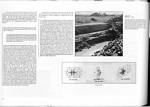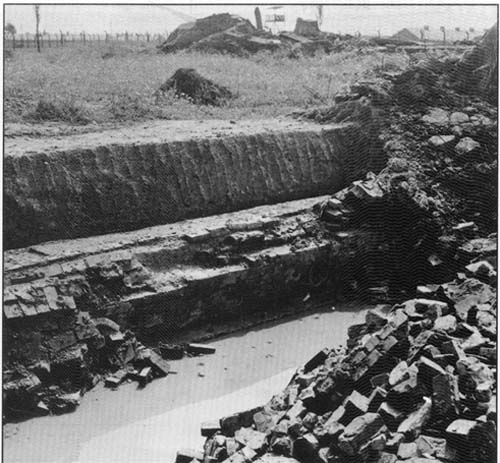|
|
 |
 |
AUSCHWITZ:
Technique
and Operation
of
the Gas Chambers © | |
|
| |
 |
Back |
 |
Contents |
Page 234 |
 |
Home
Page |
Forward |
 |
| |
| On 6th April, Vedag informed Huta that they
could not give the usual two year guarantee because the floors
(probably the basements of Krematorium Ill) had been sealed with
only one layer of damp proofing material. The firm had been warned
of this by their foreman at Birkenau, who said it was BECAUSE THESE
BUILDINGS [Krematorien II and III] WERE BUILT TO BE ONLY TEMPORARY
“weil diese Bauten nur als Vorübergehend ausgeführt werden”)
[Document 53]. |
| |
[This statement about the future of the Krematorien
goes considerably further than does Camp Commandant Hoess in his
“Commandant of Auschwitz”: |
“The crematoria were erected at the end of the two
main thoroughfares in the Birkenau camp, firstly in order not
to increase the area of the camp and consequently the safety
precautions required, and secondly so that they would not be
too far from the camp, since it was planned to use the gas
chamber, and undressing rooms as bath houses when the
extermination actions came to an end”.
|
So Hoess envisaged that once the extermination was
over, i.e. when there were no more Jews left in Europe, the gas
chambers and undressing rooms would be converted into baths and
showers. It was already with this in mind that Bischoff, through
the intermediary of Jährling, requested Topf on 15th May 1943 to
draw up the plans for 100 showers using water heated by the waste
incinerator of Krematorium III (this system was found in the
crematorium of KL Natzweiler (Struthof), where the incinerator
supplied the heat for the hot water tank for the showers next door
to the incinerator room). Traditional historians have [wrongly]
interpreted Hoess’ remark as proof that the Leichenkeller 1 of the
Krematorien could be used both as showers AND as gas chambers,
because they did not know exactly how a homicidal gas chamber
functioned at Birkenau. They thought they were they were equipped
with REAL SHOWERS with the associated pipework and imagined that
the SS could deliver toxic gas or harmless water, as they wished.
A precise knowledge of the operation of the gas chambers makes it
possible to confirm that Hoess was indeed thinking of the FUTURE
of the Krematorien, AFTER the extermination, In the author’s
opinion, this idea probably applied to 1942 and would have been
the first stage in the “white washing” of the Birkenau
Krematorien. For even if the war had ended later than it did, in
1946 or 1947, with the victory or defeat of the Germans, i.e. in
either case permitting the “round up” and “removal” of the Jews,
it is certain that at least three of the Birkenau Krematorien.
having fulfilled their “mission” and in view of their excess
number, would have been destroyed, the remaining one being
converted to appear simply a normal cremation installation for
health reasons, with or without a shower installation. What is
more, the projected later use of the Krematorien for the
annihilation of the Slav peoples is pure myth, based on no
document.] |
| |
| Messing, after having worked on 5th April on
the air on extraction system of the Krematorium III furnace the
room, worked from 6th to 11th on Leichenkeller 1, where he installed
the ventilator fan [in fact the extractor fan]. |
| |
[The ventilation system of Leichenkeller 1 in Kr III
was “improved” as compared with that of Kr II, by having an
increased number of fresh air inlets. On 18th February, 50
perforated galvanized plates, 7 x 18 cm, had been ordered for
Leichenkeller 1 of Kr II (for the air inlets near the ceiling,
spaced at intervals of 120 cm) and on 19th an unknown number of
protection “grills” of 10 mm diameter iron rod (for the air
extraction ducts, near the floor). These two orders were completed
on 15th March (the absence of these parts in no way affecting the
operation of the gas chamber). Still on 15th March, an March, an
order was issued for Leichenkeller I of Kr III for 95 perforated
zinc plates. 7 x 18 cm, (for the upper air inlets, here spaced at
60 cm intervals) and for 45 10 mm iron rod protection “grills”
(for the lower, air extraction ducts and spaced about every 150
cm). The order was completed on 23rd March. Some of the perforated
zinc plates [Document 54] were found after the Liberation
in the “Bauhof” (lying under the iron supports for the brickwork
of the 8-muffle furnace of Krematorium IV). Scrapings from the
surface of some of them were subjected to toxicological analysis
which revealed THE PRESENCE OF CYANIDES, The protection “grills”,
whose form was not known (there was a sketch in the order book of
the DAW “WL” metalworking shop, but the original is not in the
possession of the PMO and is thought to be in the Soviet Union),
were brought to light during the excavations carried out in 1968
in the ruins of the northern part of Leichenkeller 1 of
Krematorium III, along the eastern wall [Document 55] and
makes it possible to show their configuration (see sketches in
the French text: left, face view; center, side view; right,
oblique view).]. |
|
 |
Document 55
[PMO neg. no. 14500] |
| Excavations carried out on
14th August 1968 by a group of Germans from the “Sühnezeichen”
organization in the northern part of the ruins of the Krematorium
III gas chamber. It was possible to clear, at the base of the
eastern wall, three "grills" covering the air extraction vents in
the lower part of Leichenkeller 1. Unfortunately the walls of the
excavation were not consolidated and landslips caused the brick
walls to collapse, leaving a scarcely identifiable mass. |
|
|
| Document 55 bis |
 | |
| |
AUSCHWITZ:
Technique
and operation
of the gas chambers
Jean-Claude Pressac
© 1989, The
Beate Klarsfeld Foundation |
 |
Back |
Page 234 |
Forward |
 |
|

